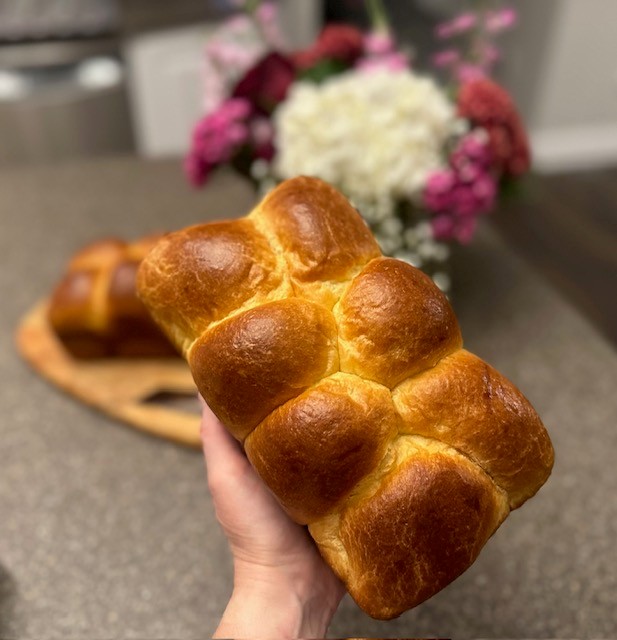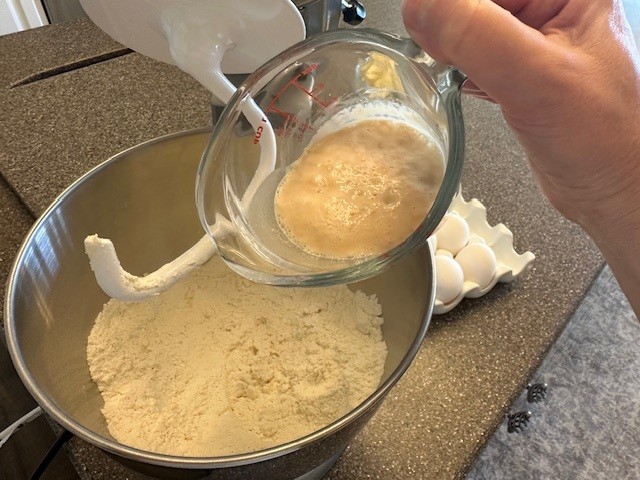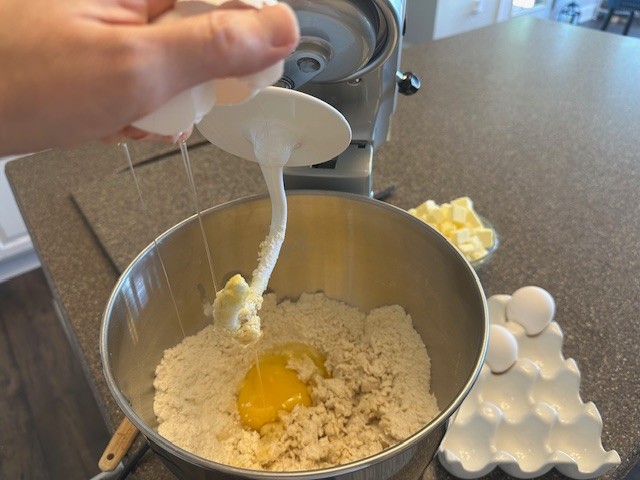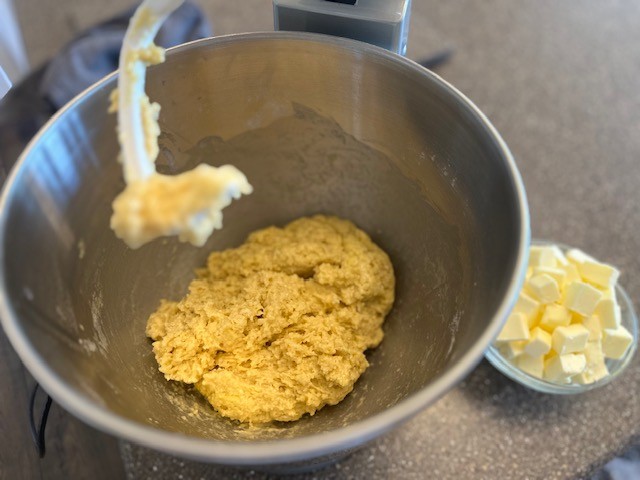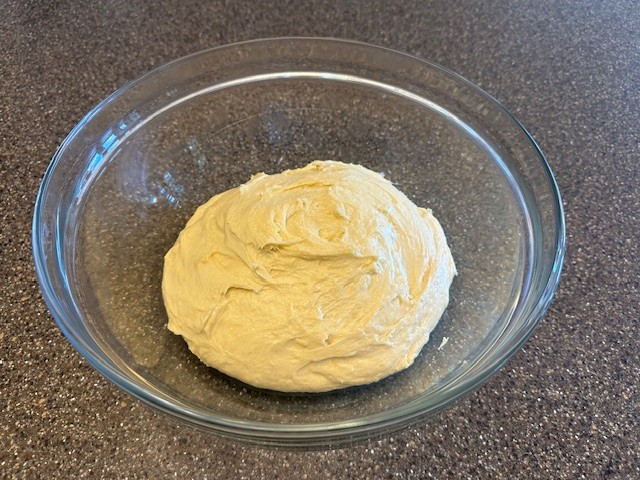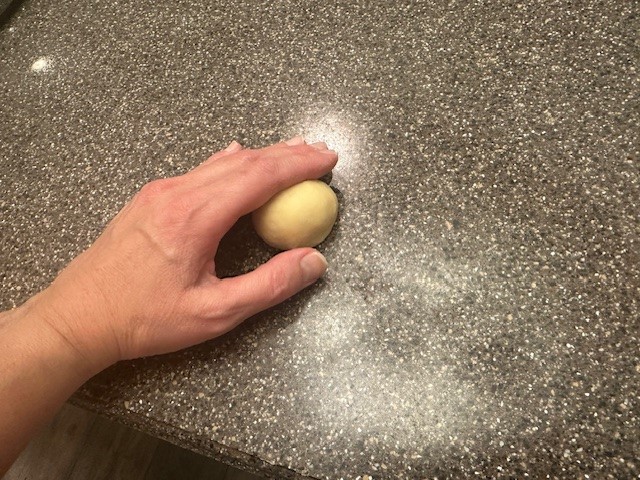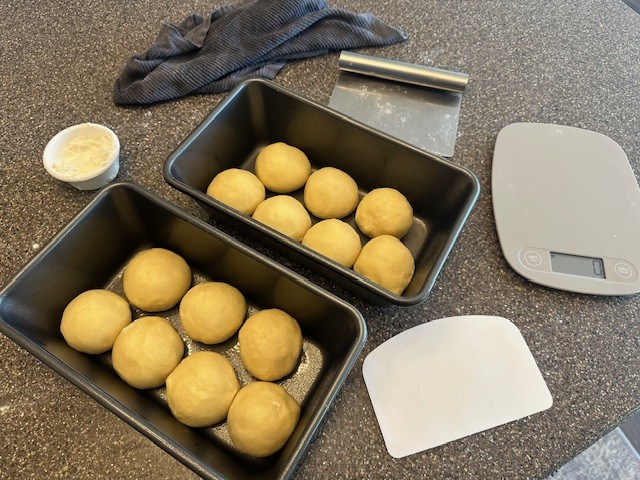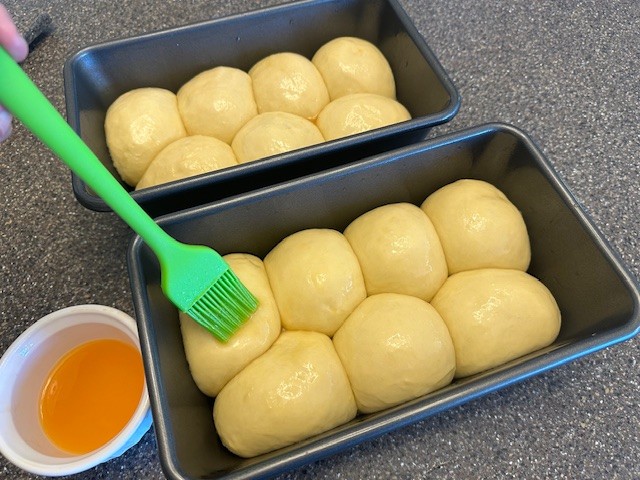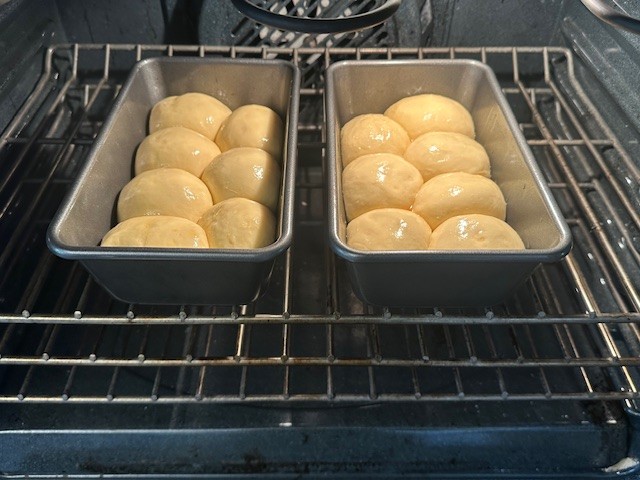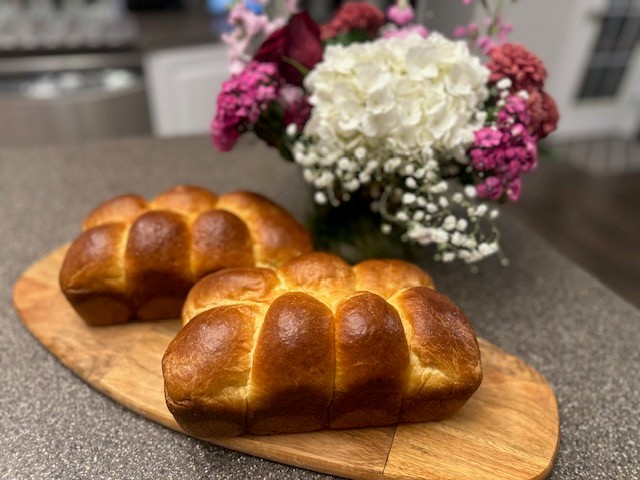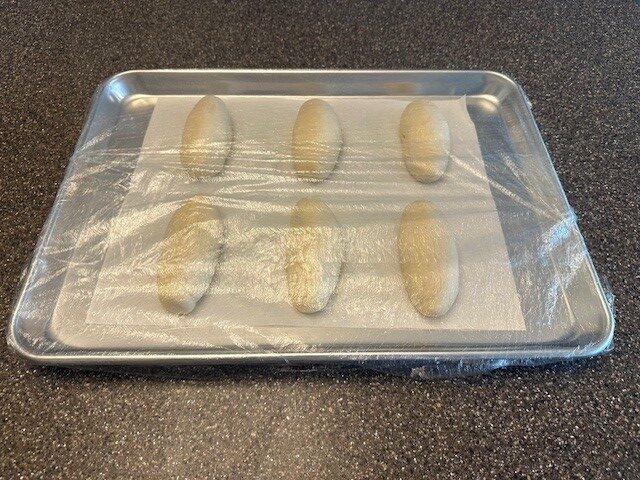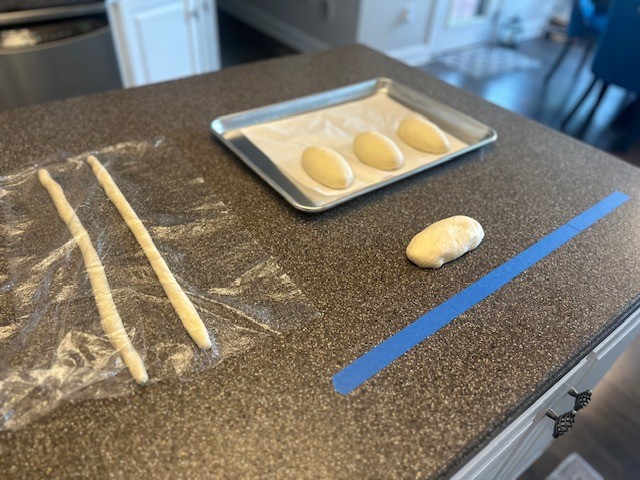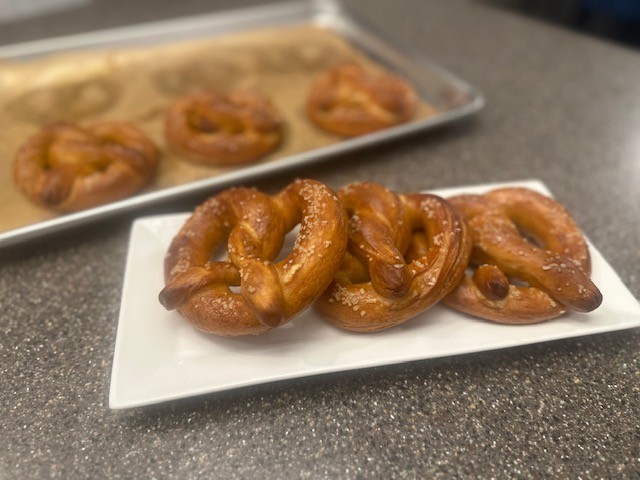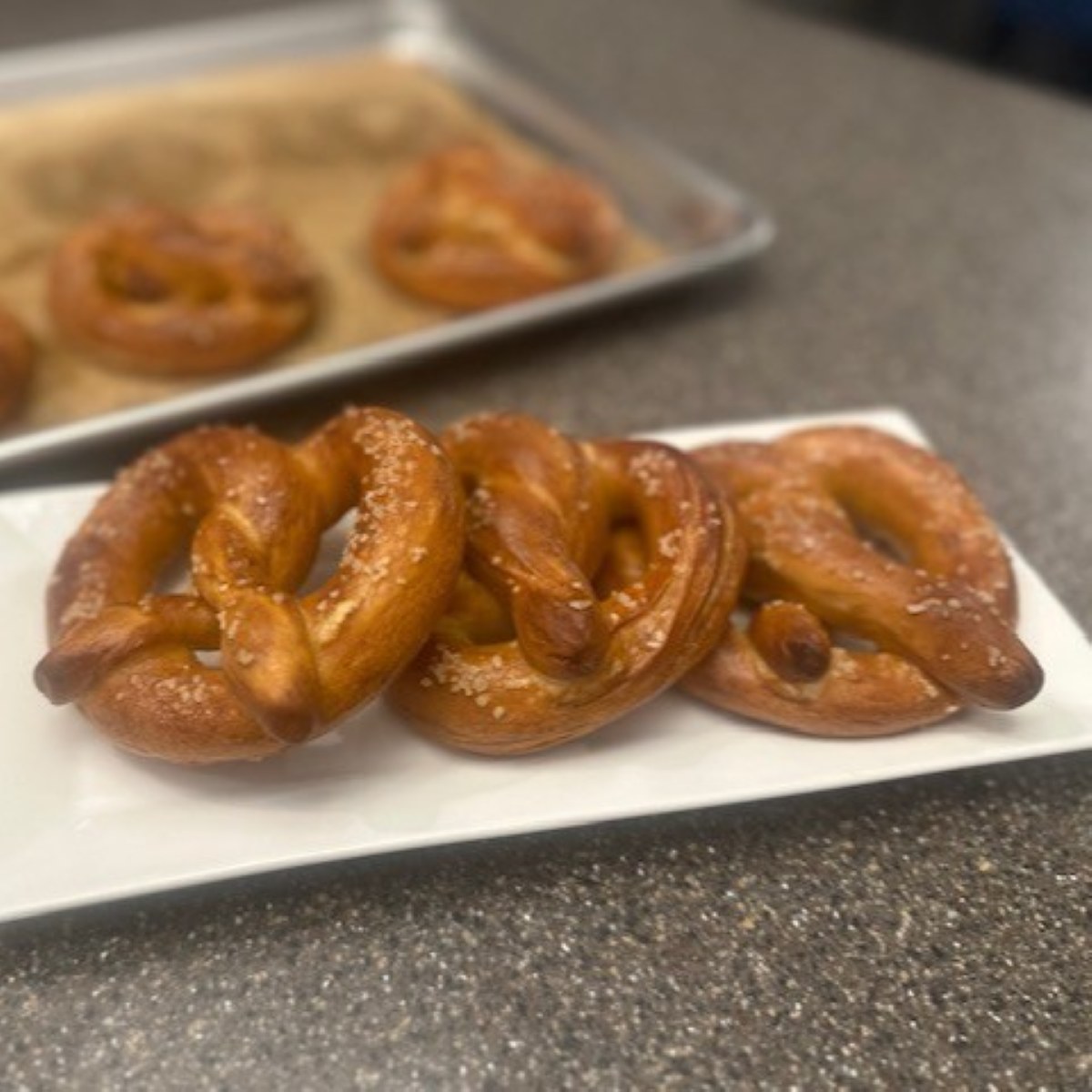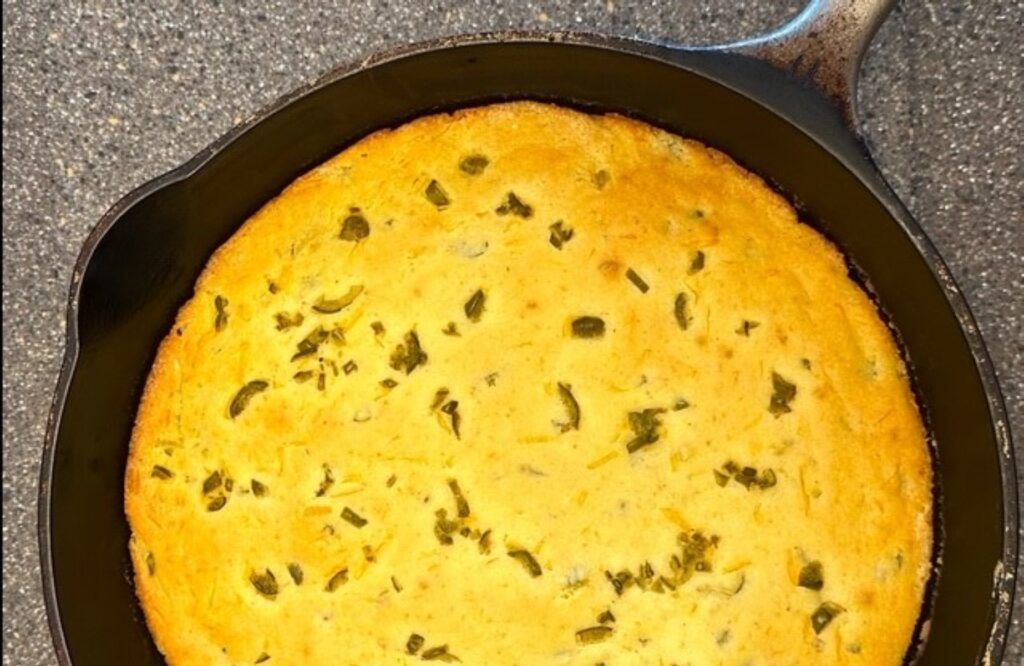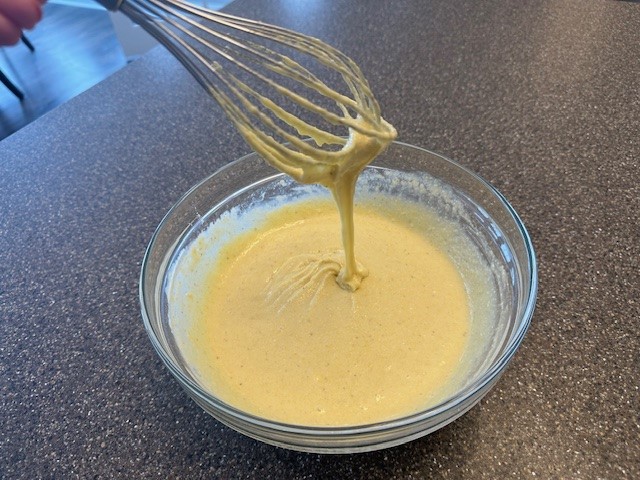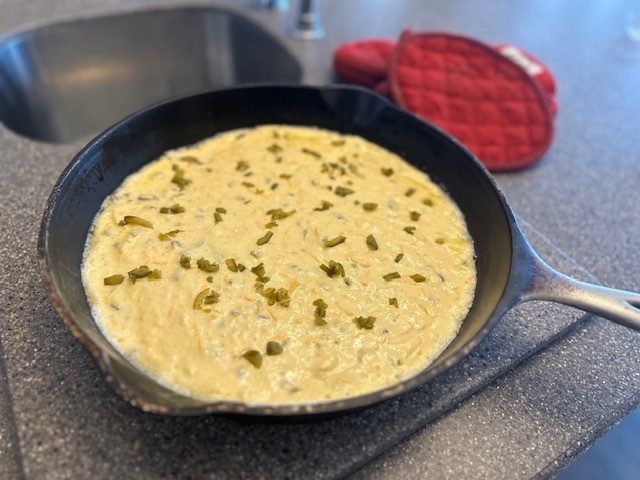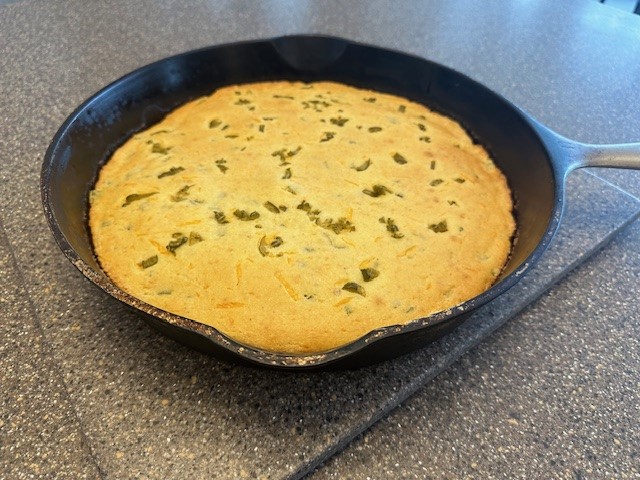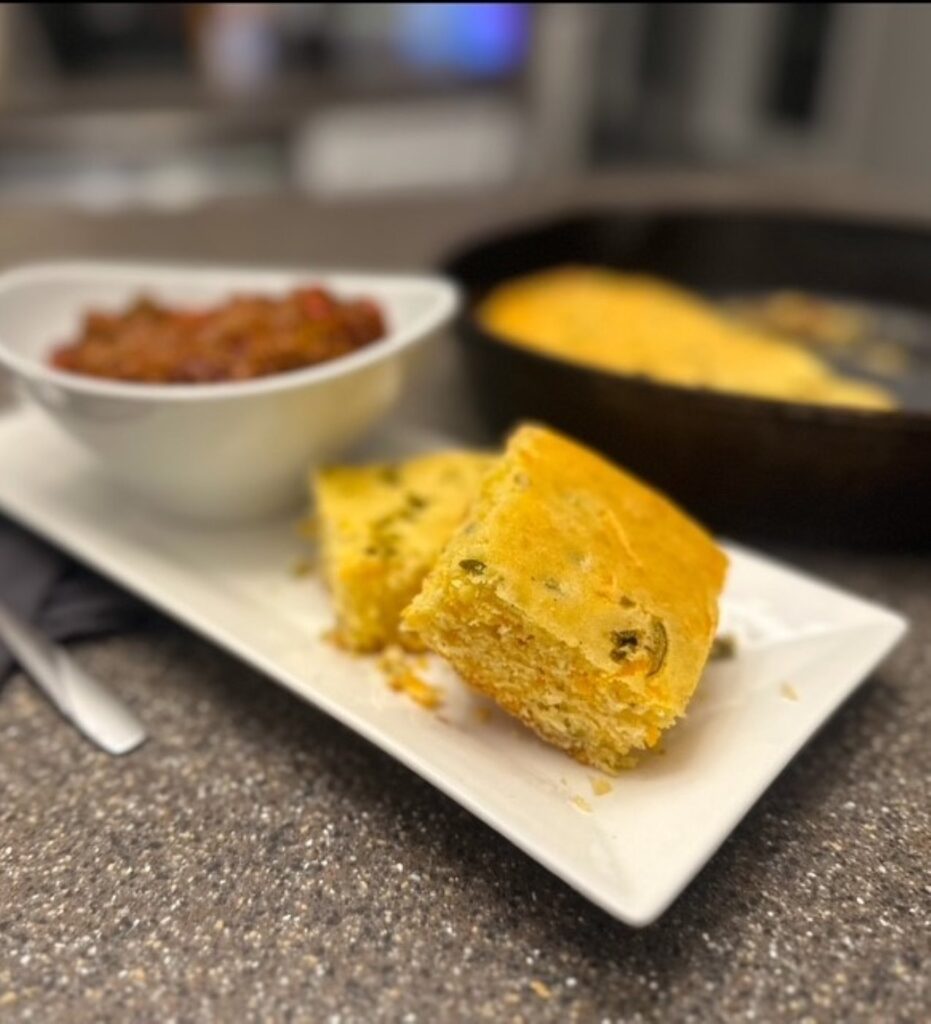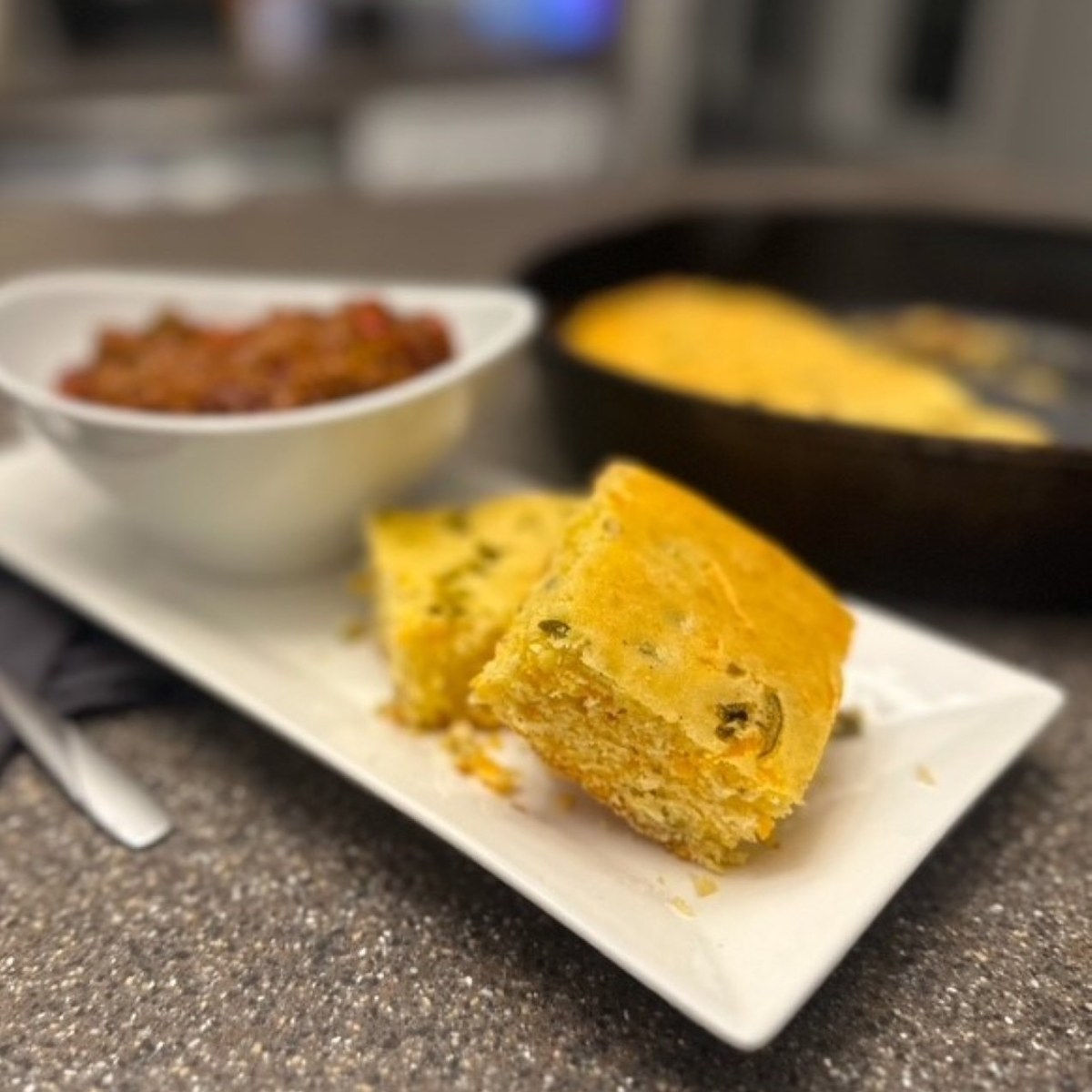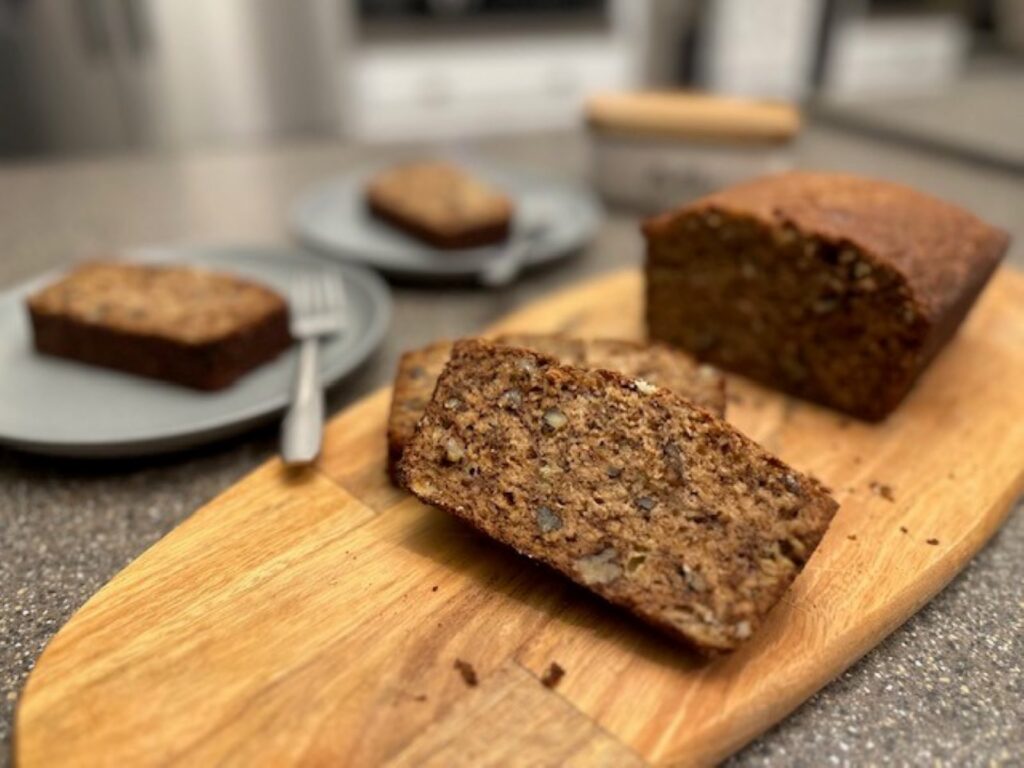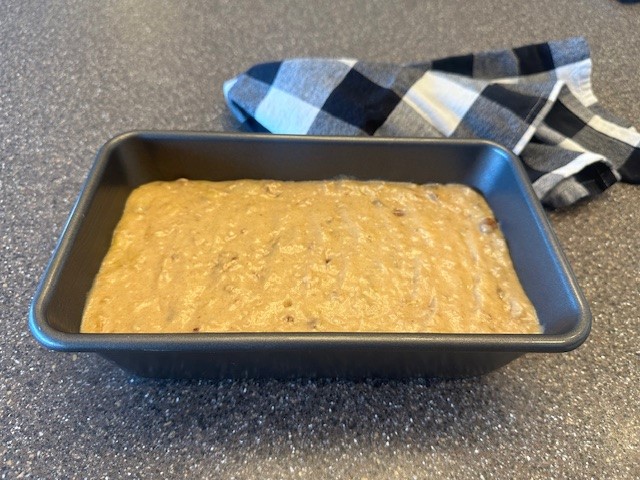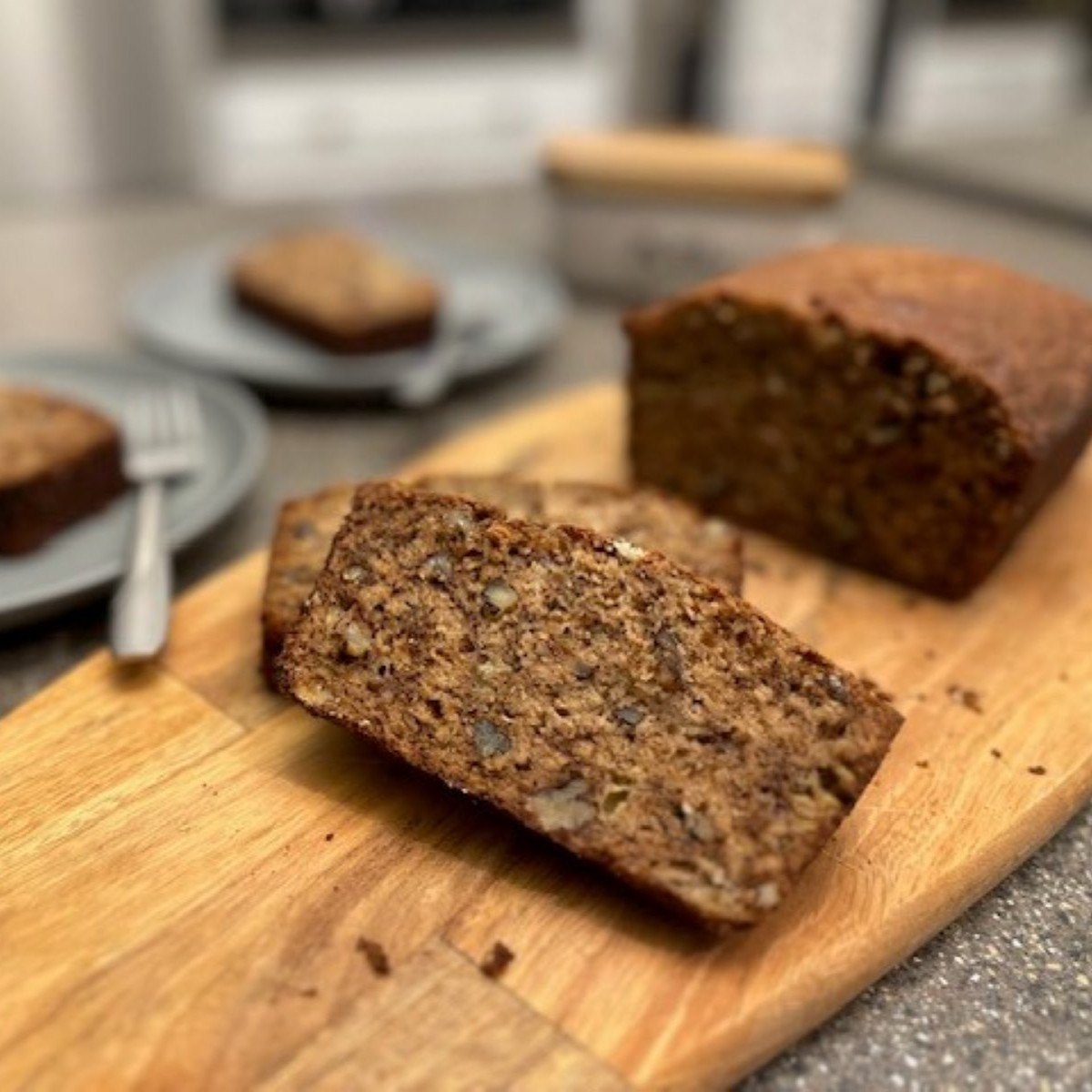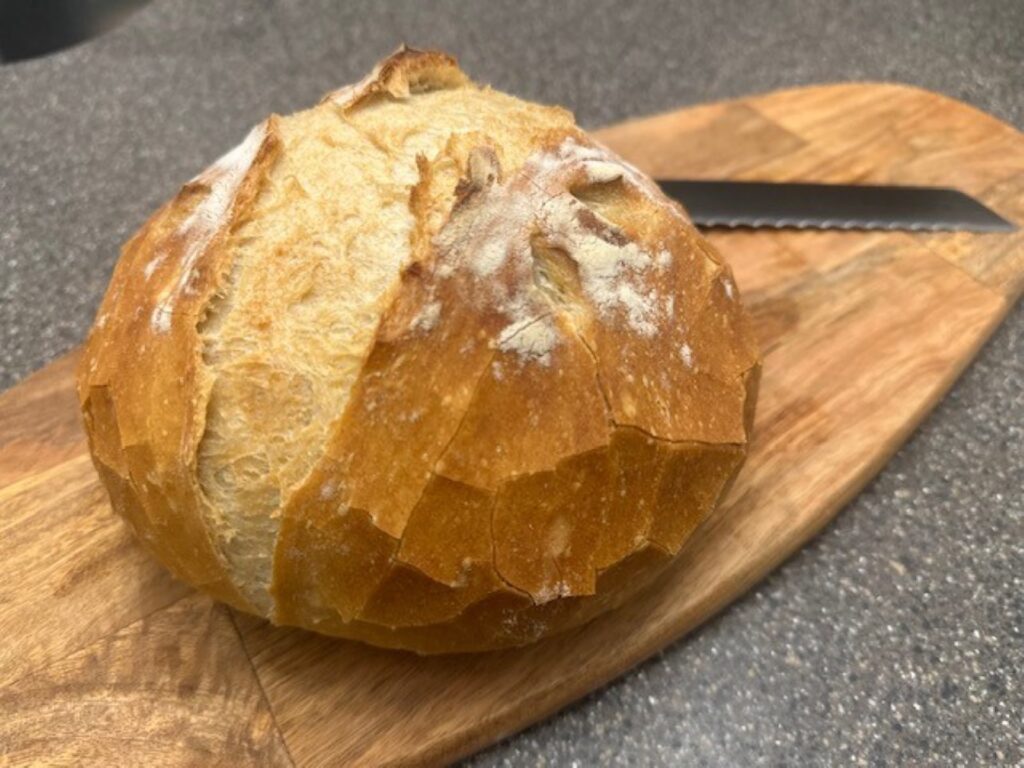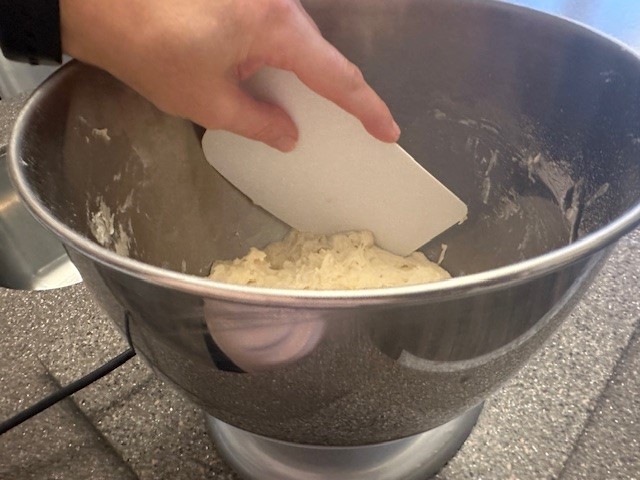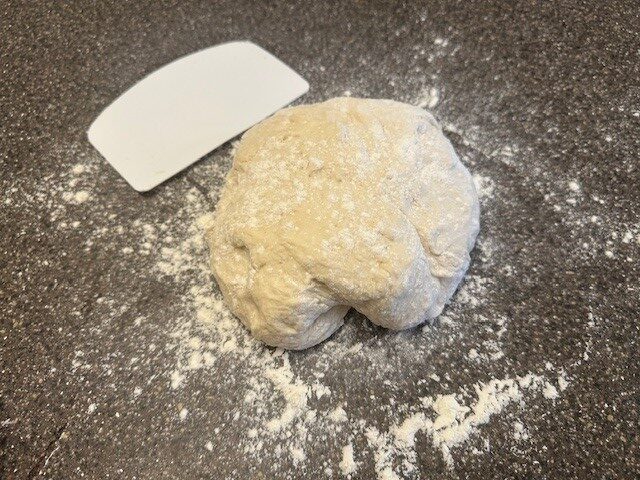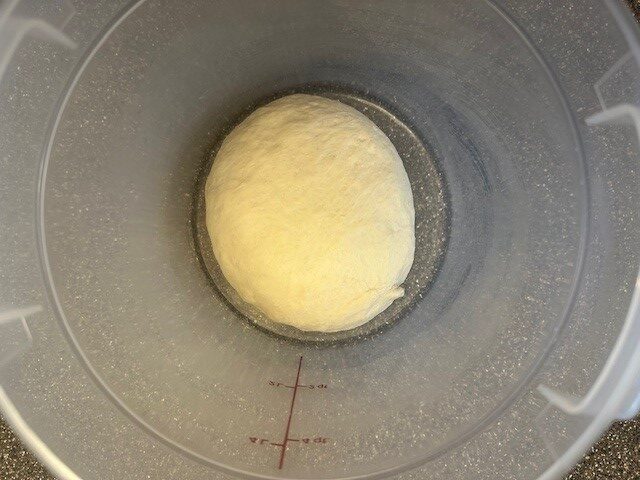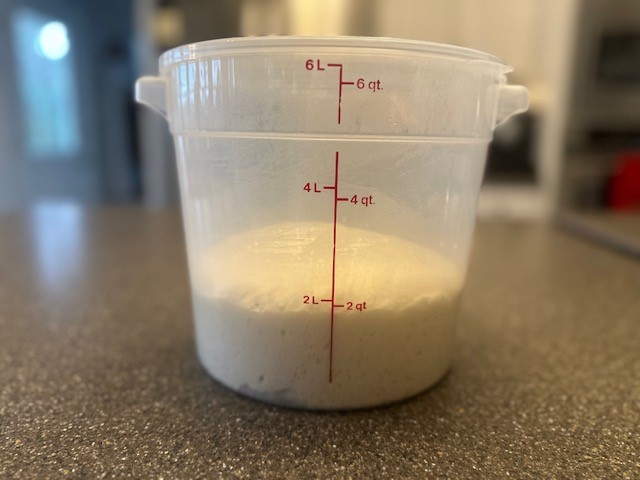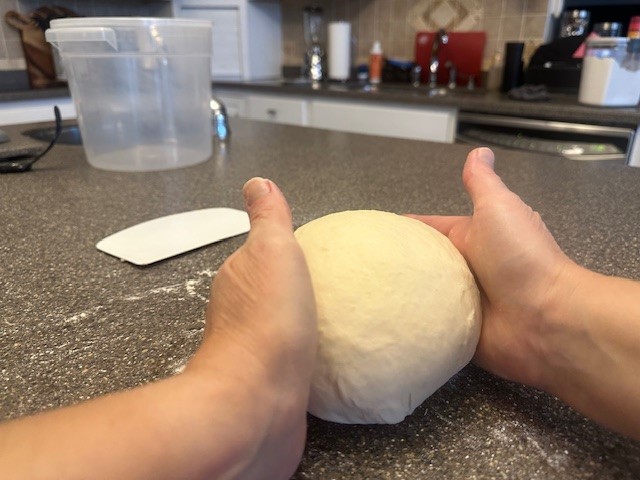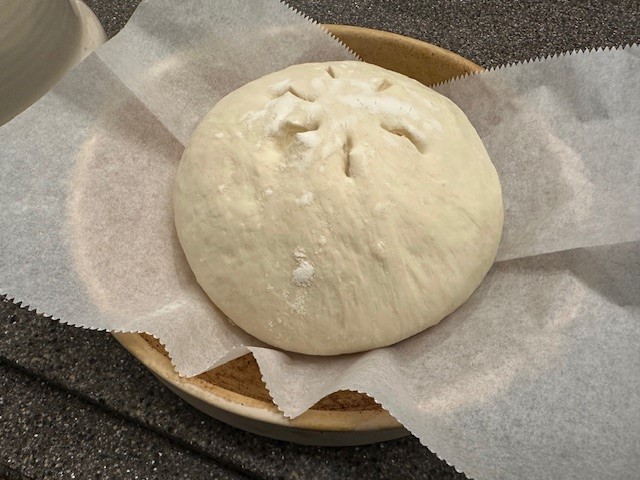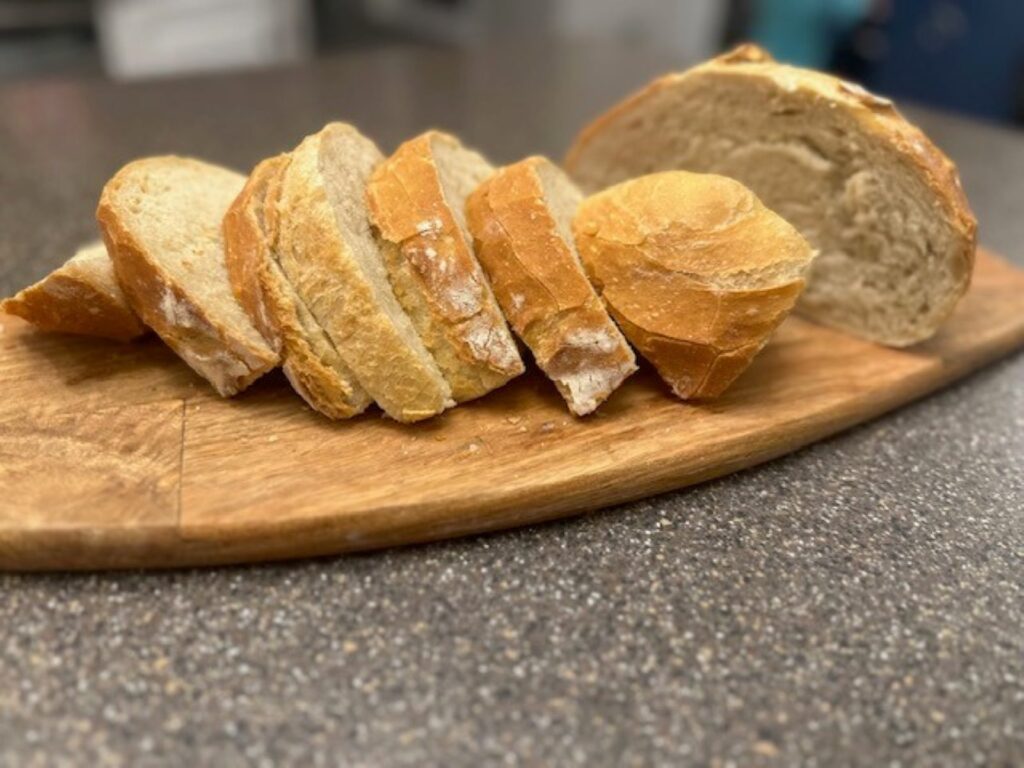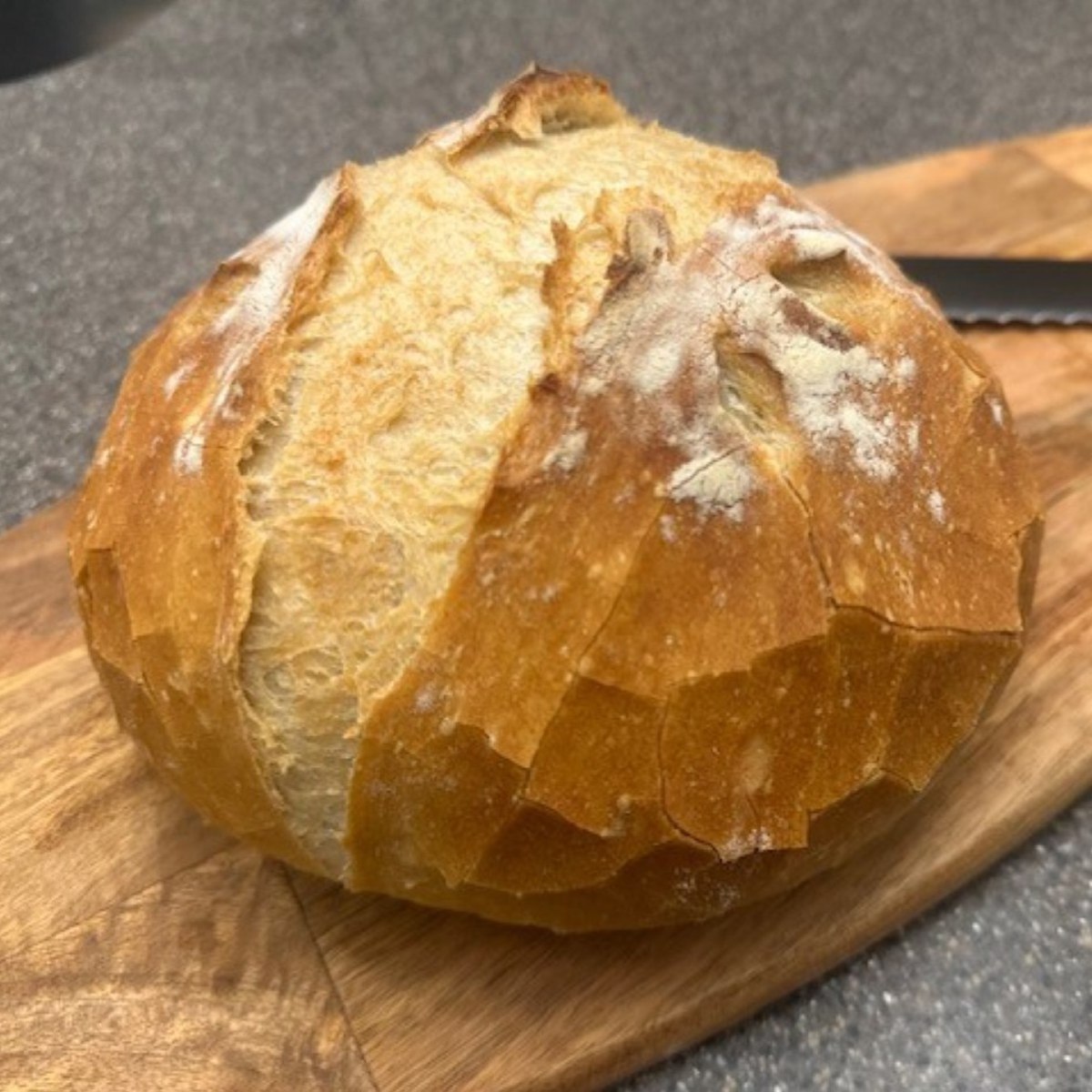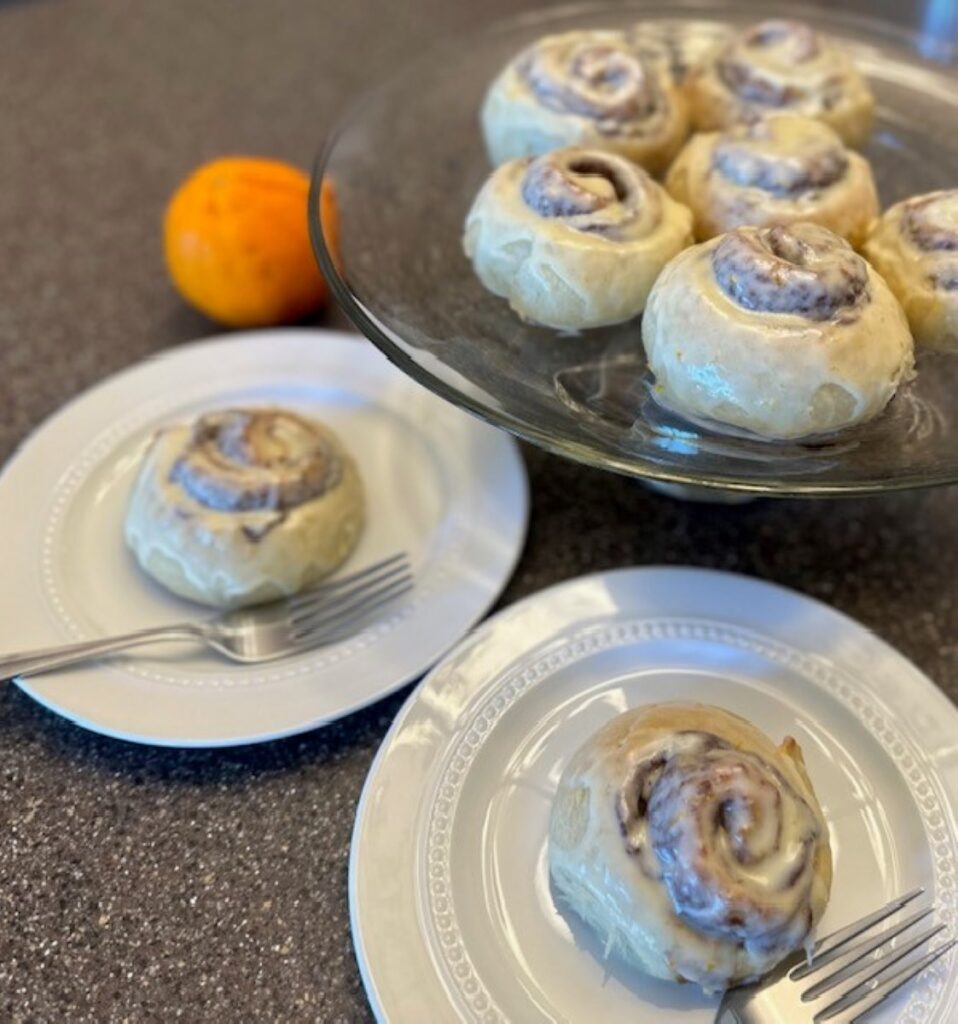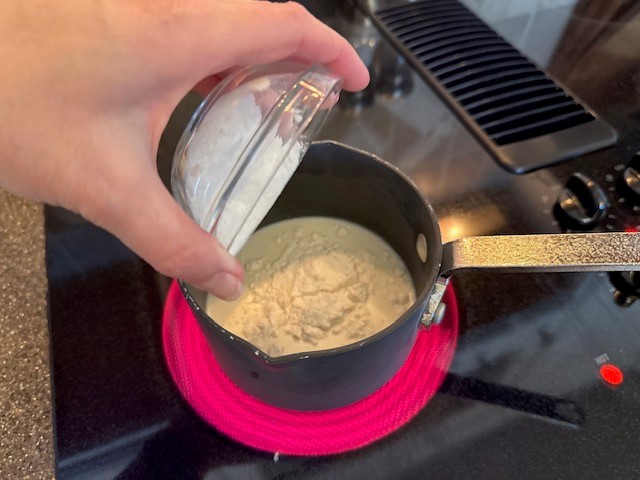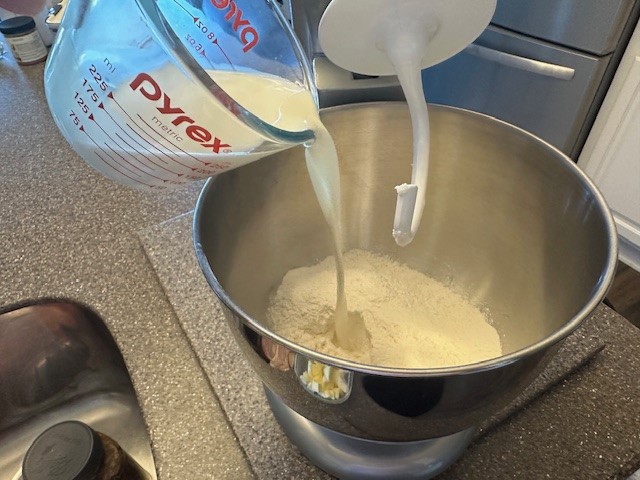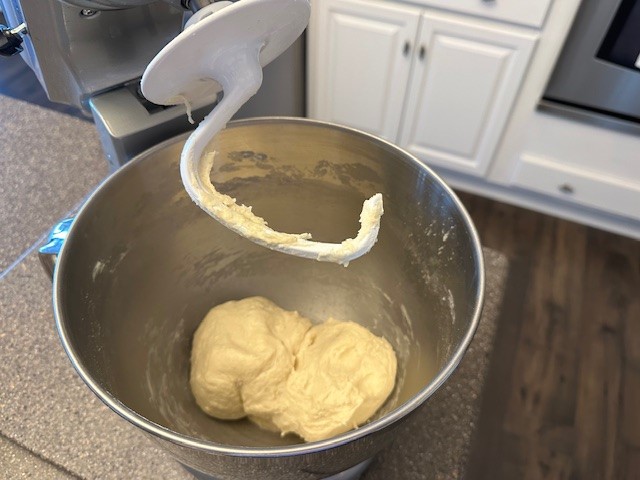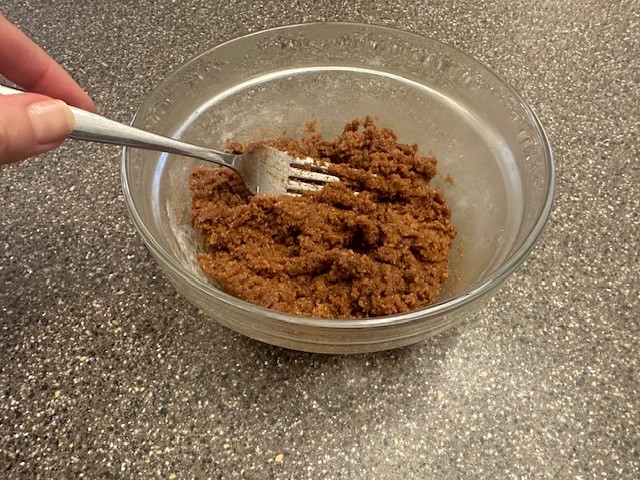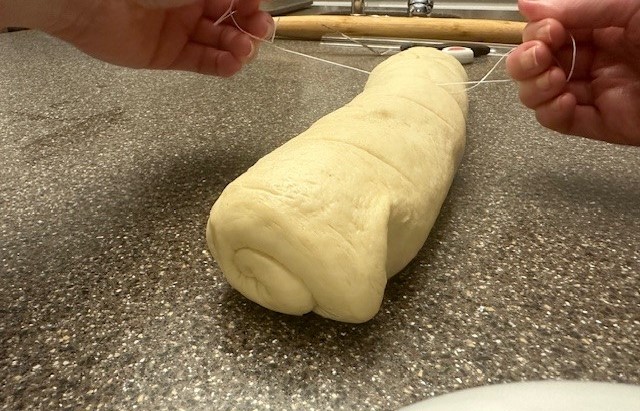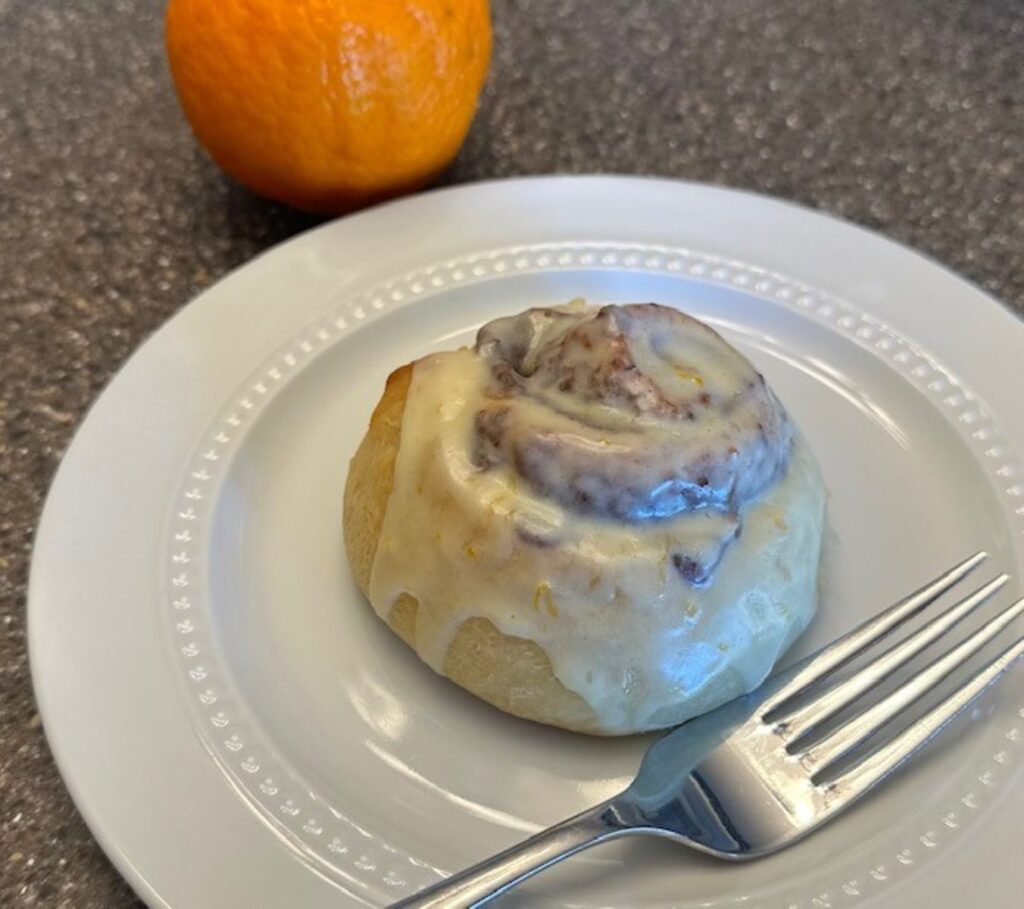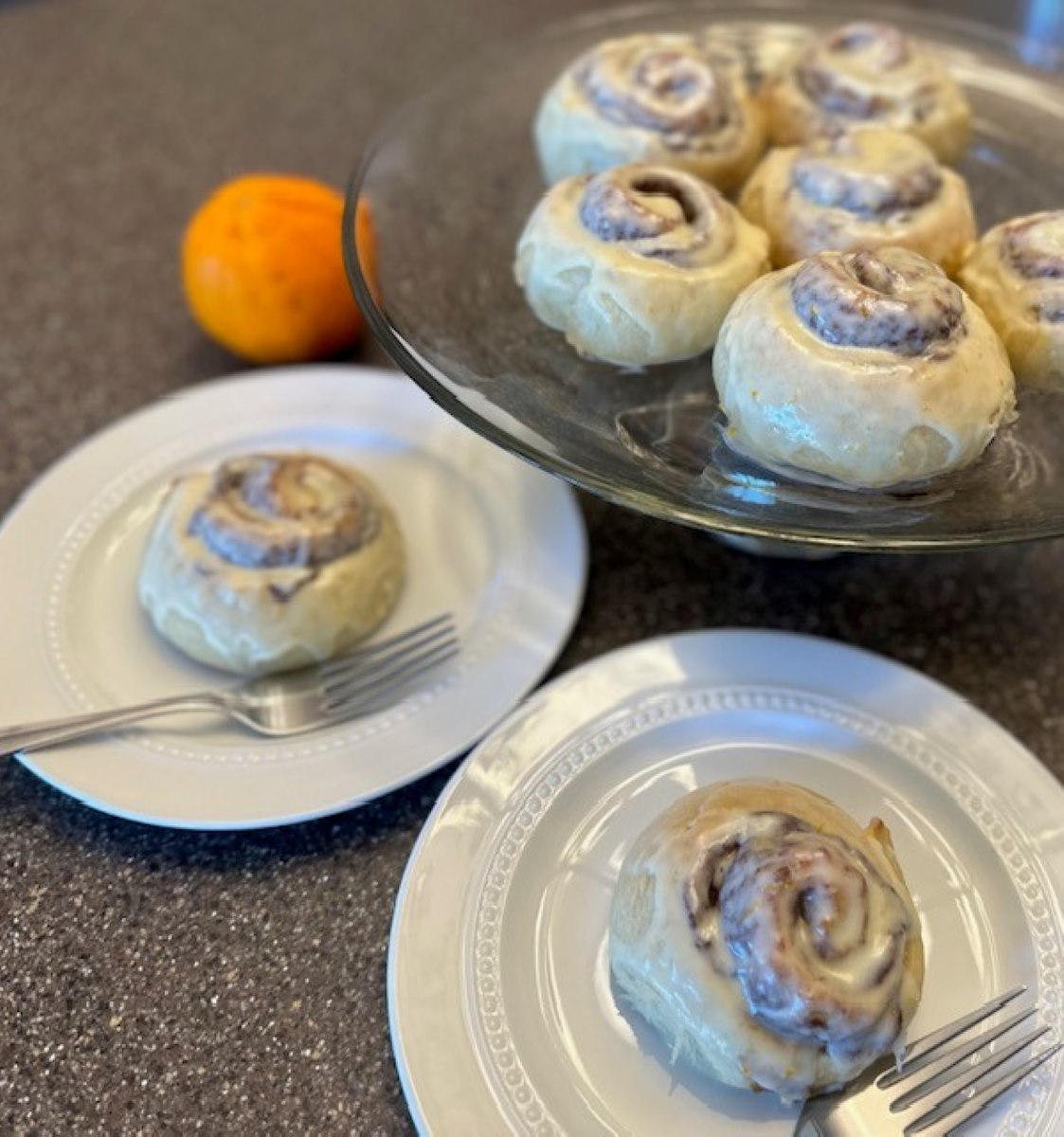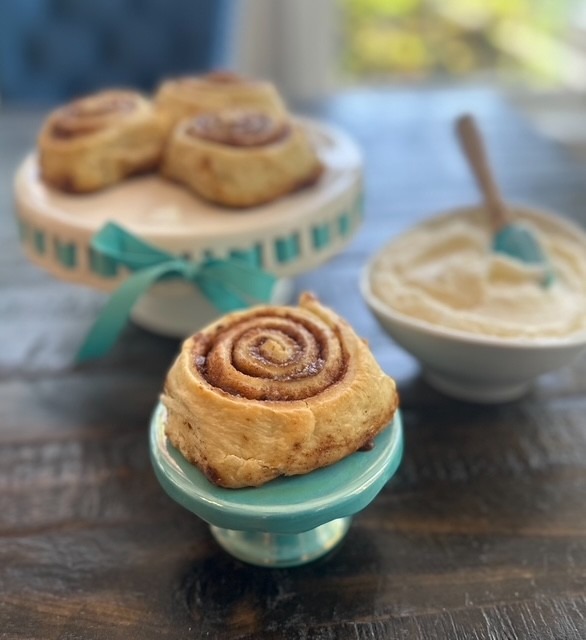
Ingredients:
Dough
- ½ + ⅔ Cup Whole Milk Divided
- 324 grams Unbleached Bread Flour Divided (2-½ Cups, 3 Tbsp.)
- 1 tsp. Kosher Salt
- 25 grams Granulated White Sugar about 2 Tablespoons
- 2-¼ tsp. Instant Yeast
- 4 Tbsp. Unsalted Butter, at Room Temperature
Cinnamon Sugar Filling
- 1 Tbsp. Unsalted Butter, Melted
- ¾ Cup Light Brown Sugar, Packed
- ¼ Cup Unbleached Bread Flour
- 1-½ Tbsp. Cinnamon
- 1 Tbsp. Granulated Sugar
- 1 Pinch Kosher Salt
Buttercream Icing
- 6 Tbsp. Unsalted Butter
- 4 Cups Powdered Sugar
- 2 tsp. Vanilla Extract
- ¼ Cup Whole Milk
- Pinch Kosher Salt
Miscellaneous Ingredients
- Cooking Spray
- 2 Tbsp. Unsalted Butter, melted to brush onto the hot baked cinnamon rolls
Instructions:
Step 1: Gather all of your dough ingredients, along with measuring cups and spoons, a digital kitchen scale, a large mixing bowl, whisk, a small pot and a stand mixer.
In two separate liquid measuring cups, measure out ½ cup milk and ⅔ cup milk.
Place your mixing bowl onto the scale, set measurement to grams, and press tare to zero out the weight of the bowl itself. Weigh 324 grams of unbleached bread flour. Scoop out 3 tablespoons of the flour and place in a small, separate bowl. This should leave you with 300 grams of flour remaining.
Note: If you don't have a scale, use the "Spoon & Sweep' method! Portion out 2-½ cups by first stirring the flour, then use a spoon to fill the measuring cups, using the handle of the spoon to level and sweep away excess. Separately, measure out 3 tablespoons of the flour and place in a small bowl.



Step 2: To the larger mixing bowl with the flour, add 6 grams of kosher salt (about 1 tsp), 25 grams of sugar (about 2 Tablespoons), and 2-¼ tsp. of instant yeast (if using a packet of dry yeast, this will be the exact amount you need). Whisk the ingredients together and set aside.

Step 3: In a small pot over medium low heat, mix together the ½ cup of milk and the 3 tablespoons of reserved bread flour. Stir using a wooden spoon until the mixture comes together to form a thick paste, and there are no visible lumps, about 2-3 minutes. Add this mixture directly to the bowl of your stand mixer.
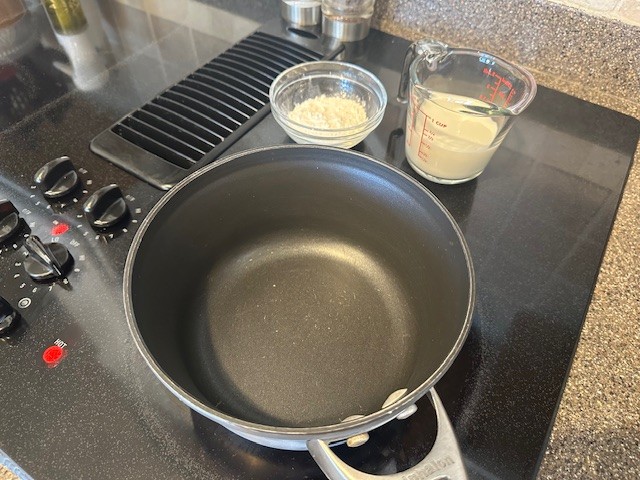


Step 4: Add the flour mixture, ⅔ cup of milk and 4 tablespoons of softened butter into the stand mixer bowl, fitted with the dough hook attachment. Run the mixer for about 10 minutes, scraping down the sides and pulling the dough from the hook midway through. You may also want to use a plastic bench scraper to pull up any unworked dough on the bottom of the bowl.
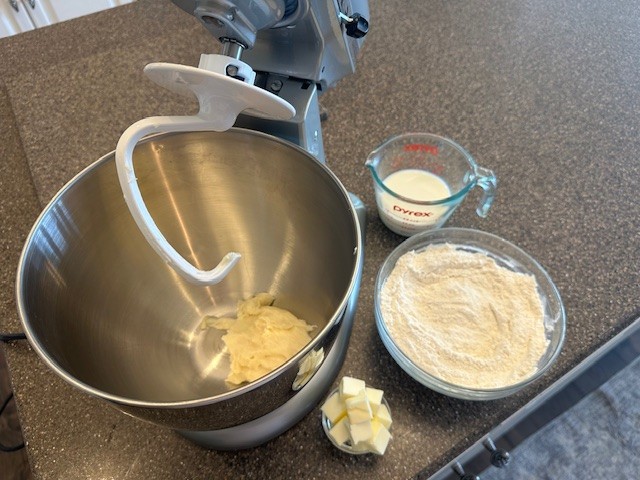
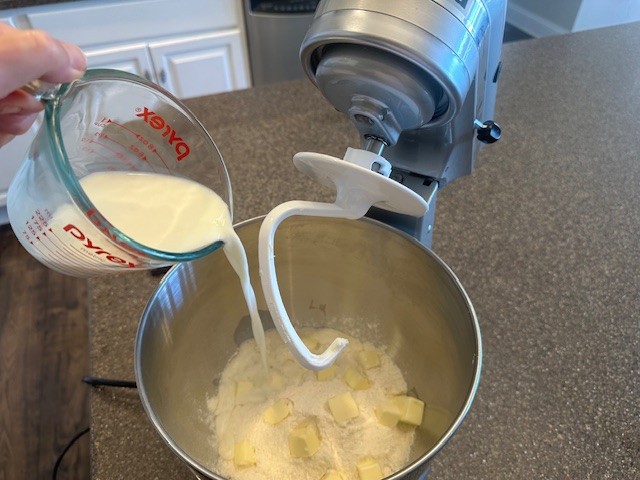
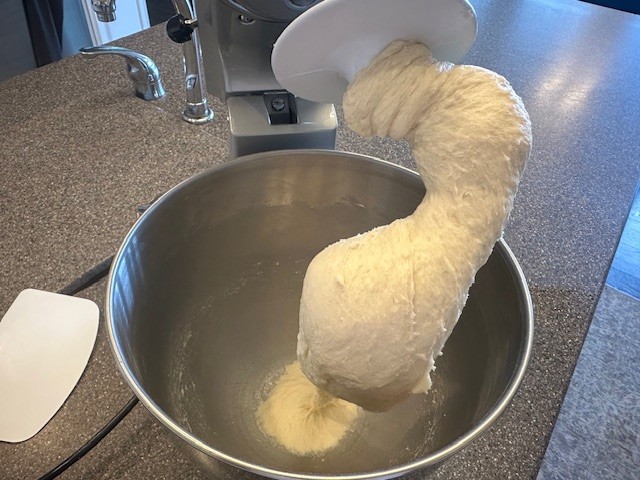
Step 5: Remove the dough from the mixing bowl, knead lightly with your hands to form into a ball, and place in a medium, glass mixing bowl sprayed lightly with cooking spray (to avoid sticking), and cover tightly with plastic wrap.
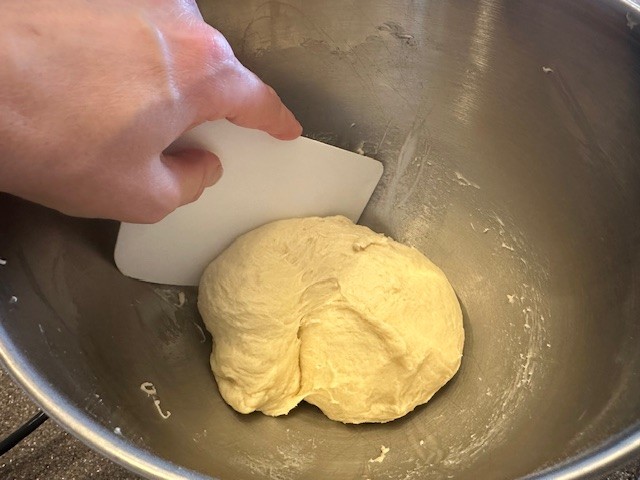

Place the bowl in a warm, draft-free area of your kitchen. If your oven has a proof setting, or even an inside light, place it here. Allow your dough to rise about 90 minutes, or just until it has about doubled in size.

Step 6: In the meantime, begin preparing the filling. Mix together the tablespoon of melted butter, ¾ cup packed light brown sugar, ¼ cup bread flour, pinch of kosher salt, cinnamon, granulated sugar, and vanilla extract. Mix everything together using a fork until the mixture comes together like heavy, wet sand. Cover and set aside.


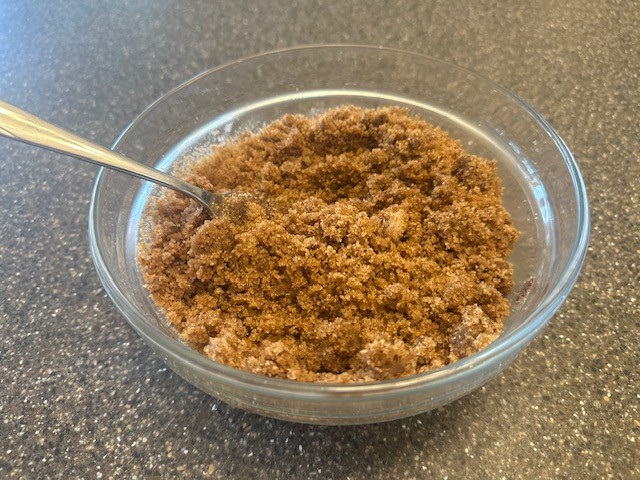
Step 7: After the dough has proofed, spray a clean work surface lightly with cooking spray. You'll want to grab a rolling pin, along with a plastic kitchen ruler, if you have one. Place the dough directly onto the surface, and using your fingertips, gently begin pressing the dough into a rectangle. The dough should be very soft and pillowy, spreading easily and not bouncing back.

Step 8: Use the rolling pin to gently roll out the dough to a 12x10 inch rectangle (the full length of a standard ruler on the long end, and just a few inches shy in depth.
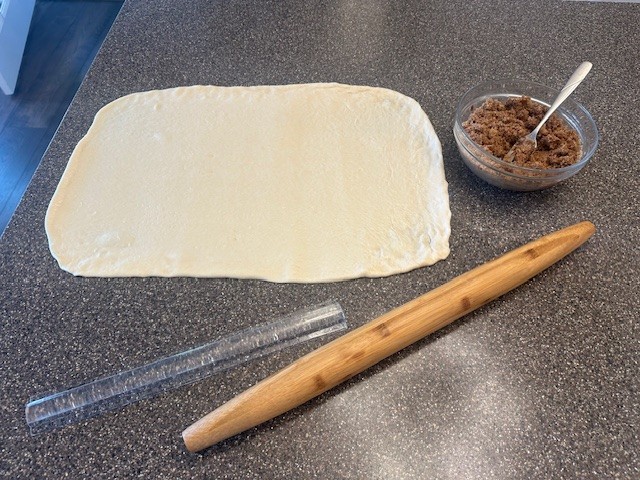
Sprinkle the surface of the dough with the filling mixture, leaving a small border around the outside.
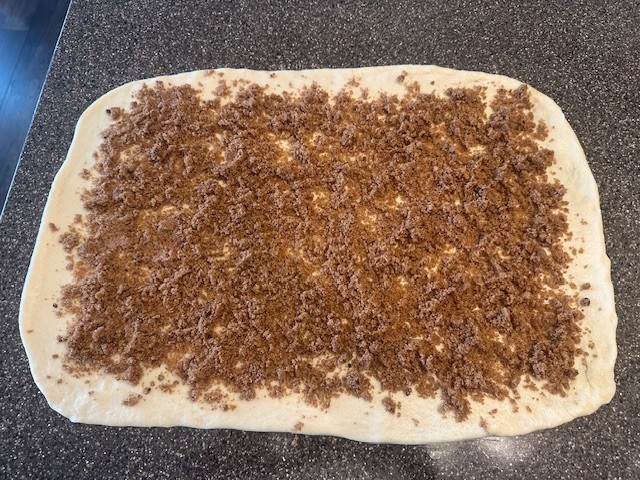
Step 9: To begin rolling, start with light fingertips along the long end of the dough, gently pressing forward from the middle out towards the ends and keeping the dough tightly sealed without pressing too firmly down.
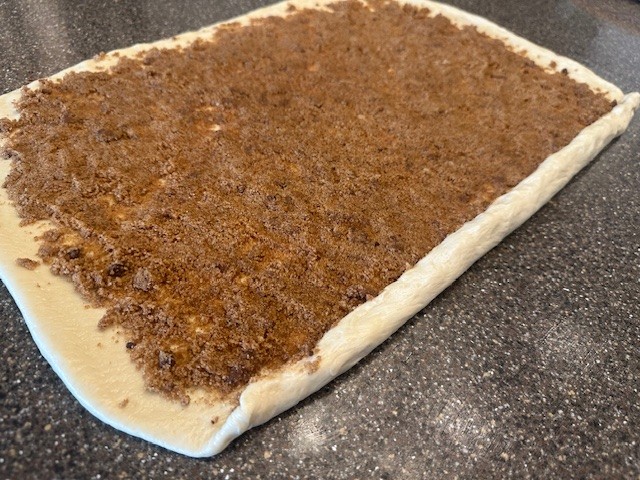
Step 10: Once the dough is fully rolled, lightly tap the ends in to ensure the roll still measures about 12 inches in length.
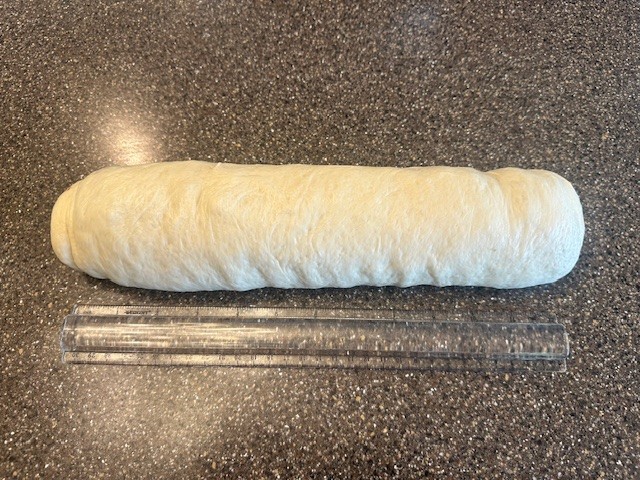
Using a knife or your bench scraper, carefully mark the dough in the center, mark each half in the center again, and again, so that you have 8 equal portions.
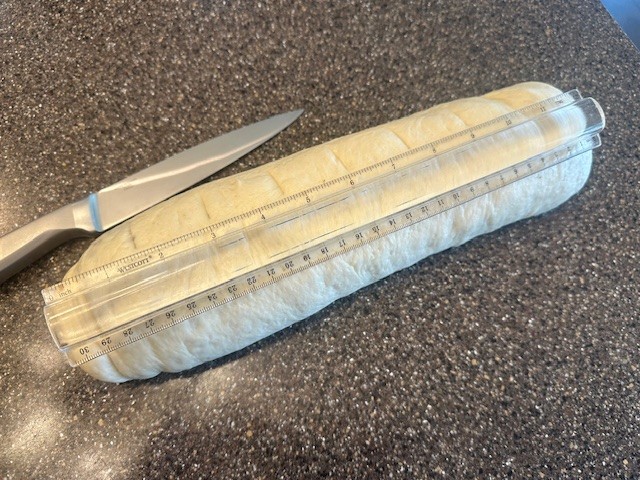
Grab a portion of dental floss, long enough that it can fit around the dough and still have plenty of room. Carefully run the floss underneath until you've reached the center mark. Cross the floss in an 'X' and pull tight. The dough will divide into two equal portions. Repeat until you have cut all 8 rolls.

Step 11: Spray a 13x9 glass baking dish with cooking spray, then place rolls into the pan. Cover the pan with plastic wrap and allow an additional one hour for the final proofing.

After 45 minutes, set the oven to 350℉ so that it will be hot about the same time that your rolls are ready for baking.
Note: If you are making these ahead, and want to bake your rolls in the morning, you can do a slow rise by placing them into refrigerator overnight and then taking them out about 90 minutes to 2 hours before baking to allow the rolls to come back to room temperature and finish proofing.
Alternatively, you can freeze these cinnamon rolls after before the second proof. After you've placed the rolls in the glass baking dish, cover tightly with plastic wrap and add a plastic lid (if you have one) or create a second tight wrap with aluminum foil. Place into the freezer until the night before you are ready to bake. Allow the rolls to thaw in the refrigerator overnight and then bring them to room temperature for about 2 hours before baking the next day.
Step 12: After the second rise, your rolls should have puffed up a bit and will be soft to the touch. Bake for 15-20 minutes in the preheated oven.
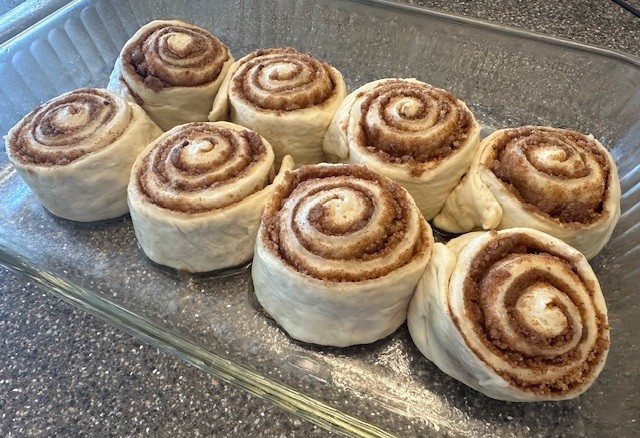
Step 13: Gather all of the ingredients to prepare the buttercream frosting. In a stand mixer fitted with the paddle attachment, cream the butter and powdered sugar, along with a pinch of salt. Start at a slow speed, and then increase as the mixture comes together, to ensure that the powdered sugar stays in the bowl. Add in the vanilla extract, and slowly drizzle in the milk, up to ¼ cup. Whip the frosting until light and fluffy, 4-5 minutes, but stiff enough to hold peaks.
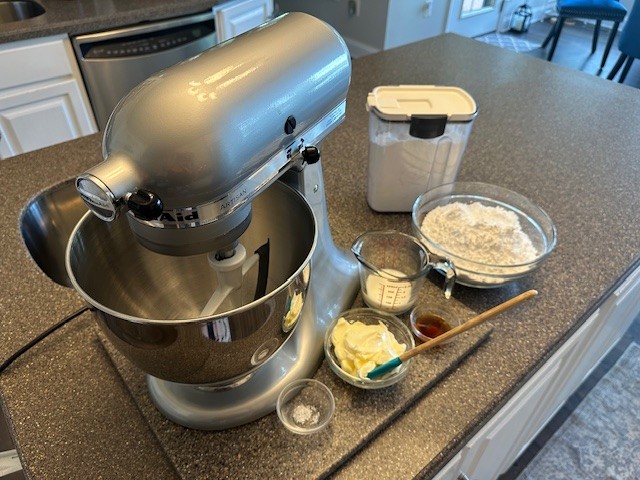
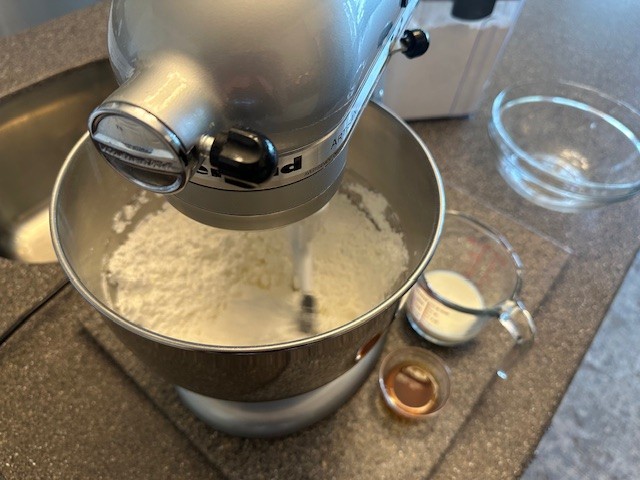
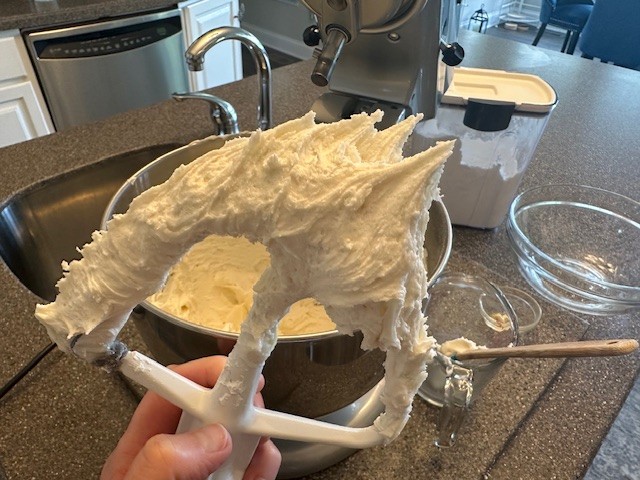
Step 15: Just before the rolls have finished baking, melt the small portion of reserved butter, then immediately brush directly onto the hot rolls after you have taken them out of the oven.
Allow the rolls to cool slightly before adding the buttercream frosting so that it doesn't completely melt.

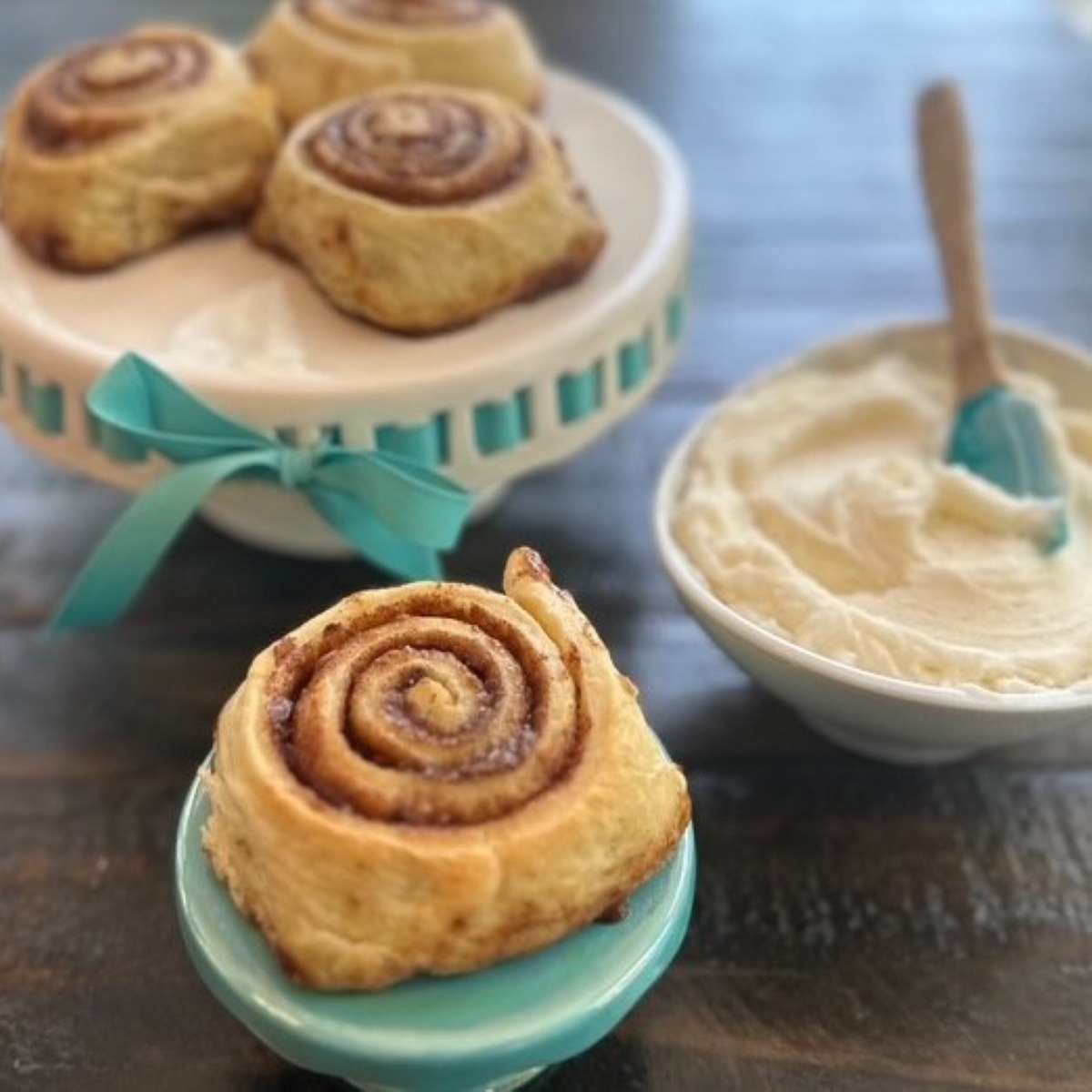
Bakery-Style Cinnamon Rolls
Equipment
- KitchenAid Stand Mixer with Dough Hook and Paddle Attachments
- Measuring Cups and Spoons
- Liquid Measuring Cups
- Large Bowl
- Small Pot
- Medium Glass Bowl
- Small, microwave-safe bowl
- Wire Whisk
- Wooden Spoon
- Fork
- Rolling Pin
- Plastic Ruler optional
- Plastic Wrap
- Dental Floss, Unflavored
- 13 x 9 Glass Baking Dish
- Rubber Spatula
- Pastry Brush
- Spoon
Ingredients
Dough
- ½ + ⅔ Cup Whole Milk Divided
- 324 grams Unbleached Bread Flour Divided (2-½ Cups, 3 Tbsp.)
- 1 tsp. Kosher Salt
- 25 grams Granulated White Sugar about 2 Tablespoons
- 2-¼ tsp. Instant Yeast
- 4 Tbsp. Unsalted Butter, at Room Temperature
Cinnamon Sugar Filling
- 1 Tbsp. Unsalted Butter, Melted
- ¾ Cup Light Brown Sugar, Packed
- ¼ Cup Unbleached Bread Flour
- 1-½ Tbsp. Cinnamon
- 1 Tbsp. Granulated Sugar
- 1 Pinch Kosher Salt
Buttercream Icing
- 8 Tbsp. Unsalted Butter, at Room Temperature 2 Sticks
- 5 Cups Powdered Sugar 5 Cups
- 2 tsp. Vanilla Extract
- ¼ Cup Whole Milk
- Pinch Kosher Salt
Miscellaneous Ingredients
- Cooking Spray
- 2 Tbsp. Unsalted Butter, melted to brush onto the hot baked cinnamon rolls
Instructions
- Gather all of your dough ingredients, along with measuring cups and spoons, a digital kitchen scale, a large mixing bowl, whisk, a small pot and a stand mixer.
- In two separate liquid measuring cups, measure out ½ cup milk and ⅔ cup milk.Place your mixing bowl onto the scale, set measurement to grams, and press tare to zero out the weight of the bowl itself. Weigh 324 grams of unbleached bread flour. Scoop out 3 tablespoons of the flour and place in a small, separate bowl. This should leave you with 300 grams of flour remaining.Note: If you don't have a scale, use the "Spoon & Sweep' method! Portion out 2-½ cups by first stirring the flour, then use a spoon to fill the measuring cups, using the handle of the spoon to level and sweep away excess. Separately, measure out 3 tablespoons of the flour and place in a small bowl.
- To the larger mixing bowl with the flour, add 6 grams of kosher salt (about 1 tsp), 25 grams of sugar (about 2 Tablespoons), and 2-¼ tsp. of instant yeast (if using a packet of dry yeast, this will be the exact amount you need.) Whisk the ingredients together and set aside.
- In a small pot over medium low heat, mix together the ½ cup of milk and the 3 tablespoons of reserved bread flour. Stir using a wooden spoon until the mixture comes together to form a paste, and there are no visible lumps, about 2-3 minutes. Add this mixture to the bowl of your stand mixer.
- Add the flour mixture, ⅔ cup of milk and 4 tablespoons of softened butter into the stand mixer bowl, fitted with the dough hook attachment. Run the mixer for about 10 minutes, scraping down the sides and pulling the dough from the hook midway through. You may also want to use a plastic bench scraper to pull up any unworked dough on the bottom of the bowl.Remove the dough from the mixing bowl, knead lightly with your hands to form into a ball, and place in a medium, glass mixing bowl sprayed lightly with cooking spray (to avoid sticking), and cover tightly with plastic wrap.Place the bowl in a warm, draft-free area of your kitchen. If your oven has a proof setting, or even an inside light, place it here. Allow your dough to rise about 90 minutes, or just until it has about doubled in size.
- In the meantime, begin preparing the filling. Mix together the tablespoon of melted butter, granulated sugar, brown sugar, bread flour, pinch of kosher salt, cinnamon, and vanilla extract. Mix everything together using a fork until the mixture comes together like heavy, wet sand. Cover and set aside.
- After the dough has proofed, spray a clean work surface lightly with cooking spray. You'll want to grab a rolling pin, along with a plastic kitchen ruler, if you have one. Place the dough directly onto the surface, and using your fingertips, gently begin pressing the dough into a rectangle. The dough should be very soft and pillowy, spreading easily and not bouncing back.
- Use the rolling pin to gently roll out the dough to a 12x10 inch rectangle (the full length of a standard ruler on the long end, and just a few inches shy in depth.Sprinkle the surface of the dough with the filling mixture, leaving a small border around the outside.
- To begin rolling, start with light fingertips along the long end of the dough, gently pressing forward from the middle out towards the ends and keeping the dough tightly sealed without pressing too firmly down.
- Once the dough is fully rolled, lightly tap the ends in to ensure the roll still measures about 12 inches in length.Using a knife or your bench scraper, carefully mark the dough in the center, mark each half in the center again, and again, so that you have 8 equal portions.Grab a portion of dental floss, long enough that it can fit around the dough and still have plenty of room. Carefully run the floss underneath until you've reached the center mark. Cross the floss in an 'X' and pull tight. The dough will divide into two equal portions. Repeat until you have cut all 8 rolls.
- Spray a 13x9 glass baking dish cooking spray, then place rolls into the pan. Cover the pan with plastic wrap and allow an additional hour for the final proofing.After 45 minutes, set the oven to 350℉ so that it will be hot about the same time that your rolls are ready for baking.Note: If you are making these ahead, and want to bake your rolls in the morning, you can do a slow rise by placing them into refrigerator overnight and then taking them out about 90 minutes to 2 hours before baking to allow the rolls to come back to room temperature and finish proofing. Alternatively, you can freeze these cinnamon rolls after before the second proof. After you've placed the rolls in the glass baking dish, cover tightly with plastic wrap and add a plastic lid (if you have one) or create a second tight wrap with aluminum foil. Place into the freezer until the night before you are ready to bake. Allow the rolls to thaw in the refrigerator overnight and then bring them to room temperature for about 2 hours before baking the next day.
- After the second rise, your rolls should have puffed up a bit and will be soft to the touch. Bake for 15-20 minutes in the preheated oven.
- Gather all of the ingredients to prepare the buttercream frosting. In a stand mixer fitted with the paddle attachment, cream the butter and powdered sugar, along with a pinch of salt. Add in the vanilla extract, and slowly drizzle in the milk, up to ¼ cup. Whip the frosting until light and fluffy, 4-5 minutes, but stiff enough to hold peaks.
- Just before the rolls have finished baking, melt the small portion of reserved butter, then immediately brush directly onto the hot rolls after you have taken them out of the oven. Allow the rolls to cool slightly before adding the buttercream so the frosting doesn't completely melt.
